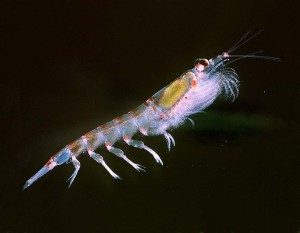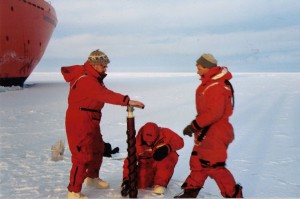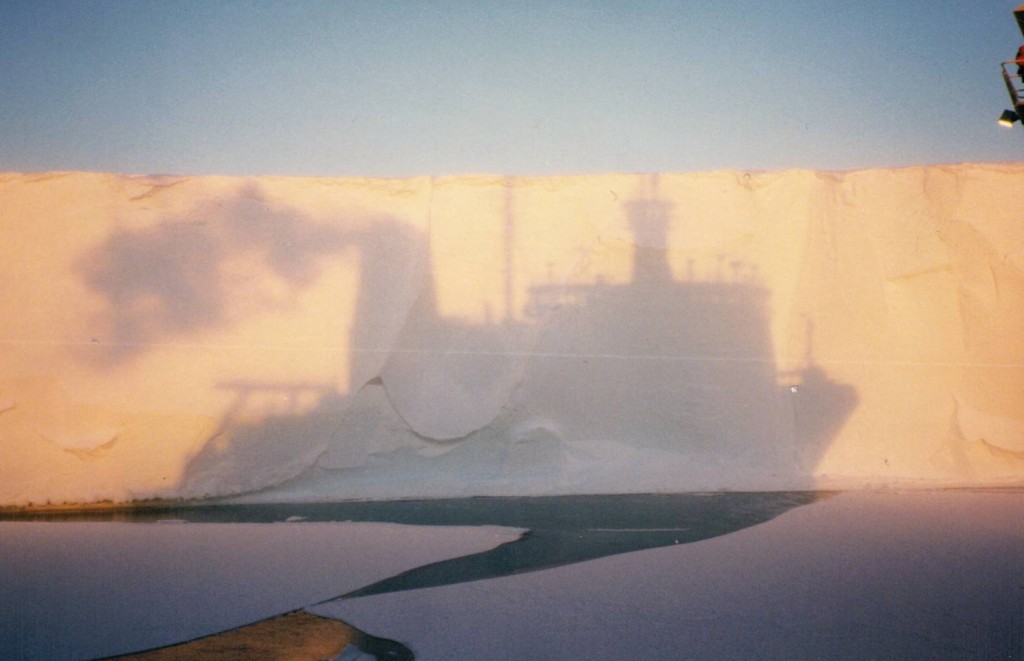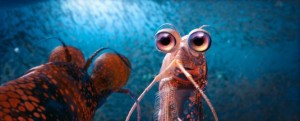 As far as obscure ecosystems go, the outer edge of expanding sea-ice sheets has got to be near the top of the list. Not algae-living-in-sloth-hairs obscure, I suppose, but then the algae that grow inside the sea ice have a significantly greater impact on just about everything else in the world, other than sloth hair. Sea ice represents a fascinating bit of physical structure in the otherwise largely structure-less surface of the polar seas. And it’s more complex than many people realize. It’s riddled with cracks and fissures, and honeycombed with channels and pockets of super-salty brine, left behind as seawater freezes into largely salt-free ice. For organisms smaller than an inch or two long, the ice edge is a terrain as rich and varied as a coral reef or a tropical rainforest.
As far as obscure ecosystems go, the outer edge of expanding sea-ice sheets has got to be near the top of the list. Not algae-living-in-sloth-hairs obscure, I suppose, but then the algae that grow inside the sea ice have a significantly greater impact on just about everything else in the world, other than sloth hair. Sea ice represents a fascinating bit of physical structure in the otherwise largely structure-less surface of the polar seas. And it’s more complex than many people realize. It’s riddled with cracks and fissures, and honeycombed with channels and pockets of super-salty brine, left behind as seawater freezes into largely salt-free ice. For organisms smaller than an inch or two long, the ice edge is a terrain as rich and varied as a coral reef or a tropical rainforest.
For three or four years in the 1990s, I was obsessed with the structure of growing sea ice, and especially with the life that structure supported. My first job in grad school was to figure out a way to capture images of the microbial communities living inside the brine pockets and fissures of Antarctic sea ice—and my last was to plant my feet on that sea ice with a coring augur, and bore down into it to collect samples. I spent countless hours learning about the ice and the organisms that lived in it, and months running thought experiments, tinkering in the lab and racing frostbite to capture untainted samples of the ice’s underside, where all the biological action is. I even deployed plankton nets, many times, with the express purpose of capturing not the giant Antarctic krill, Euphausia superba, but its feces.
I immersed so far, I might as well have been living in a brine pocket myself. But I’d never really seen what goes on at the ice edge until Warner Bros. showed me. That’s right—the trailers for Happy Feet Two, opening now, feature what must be the world’s first-ever animated krill. I suppose this is how the clownfish people must have felt when Nemo broke big.
For large parts of the year, the algae growing within sea ice forms the base of the marine food web in Antarctica, supporting everything from nutrient-recycling bacterial communities to penguins, elephant seals and massive whales. They also produce globally significant amounts of oxygen, while pulling climate warming carbon dioxide out of the atmosphere and exporting it to the deepest reaches of the ocean. Krill are the major link in both those processes, pumping carbon and other nutrients up the food chain as they are eaten by squid, fish and whales, and down to the salty deep as they package their waste in tidy little chitin-sheathed bundles called fecal pellets.
 You won’t find those fecal pellets in Happy Feet Two—at least, I don’t think so. But that’s okay. It’s a penguin cartoon after all, and I’m not going to quibble about missing euphausid poop any more than I am about other blown details. (Penguins don’t actually sing and dance, Robin Williams hasn’t been charming in decades.) Instead, I’m just going to celebrate a rare moment when the biologically obscure gets made cinematographically relevant. How very much easier it would have been to explain my work to civilians if only I’d had Bill and Will the Krill as a reference point.
You won’t find those fecal pellets in Happy Feet Two—at least, I don’t think so. But that’s okay. It’s a penguin cartoon after all, and I’m not going to quibble about missing euphausid poop any more than I am about other blown details. (Penguins don’t actually sing and dance, Robin Williams hasn’t been charming in decades.) Instead, I’m just going to celebrate a rare moment when the biologically obscure gets made cinematographically relevant. How very much easier it would have been to explain my work to civilians if only I’d had Bill and Will the Krill as a reference point.
In its small way, Happy Feet Two represents the triumph of the idea of biodiversity. When I was growing up, animated movies were about mice (Mickey), ducks (Donald) or at best, the woodland creatures of ‘Bambi’ or the tropical beasts of ‘Jungle Book.’ But today’s children get exposed to so much more of biology’s rich tapestry—Nemo and the marine realm, the small-scale world of ‘A Bug’s Life,’ the Pleistocene delights of ‘Ice Age.’
Sure a lot of it is corny, all of it is anthropomorphized, and the cutest animals still get to star. But a love of biology always starts with delight in the natural world. Who’s to say that delight can’t be sparked on the big screen, especially when its once-obscure object is too far away to visit? I for one can’t wait for the plush krill dolls that are sure to follow–even if they aren’t biologically accurate down to the last detail.
***
Images Top: Euphausia superba, Professor Dr. habil. Uwe Kils via wikimedia commons. Middle: Bill and Will face off in Happy Feet Two, Warner Bros. Bottom: The author, left, working hard to get what is now available in a theater near you. Photographer not remembered. Below: Ice breaker Nathaniel B. Palmer, with fecal pellet samples safely on board, casts its shadow against the 90-meter face of the Ross Ice Shelf. Photo by the (tired, cold) author.

Interesting article. I knew about krill’s place in the foodchain, but not of its waste disposal system.
With the importance that krill have in the balance of nature, it makes me despair even more that humans are now harvesting krill from the oceans.
Tired and cold you may have been, Mr Hayden, but that last image of the icebreaker’s shadow is wonderful, unique and abstract.
@nzm, thanks so much for the comment. You’re absolutely right–the booming commercial harvest of Antarctic krill, primarily for “fish chow” for commercial aquaculture, and also for “fish” oil health supplements, is potentially devastating. It’s probably too much to hope for that a little anthropomorphism might help bring more attention to the dangers of a massive krill harvest, but hope I do.
As for the photos–thanks doubly. It was one of those sweet moments of calm beauty that seem to emerge unexpectedly in Antarctica, and I’m just glad I thought to take a photo. It was something I rarely did in those days.
very nice, tom. i especially liked this:
“But a love of biology always starts with delight in the natural world.”
a powerful insight. i think e.o. wilson would agree with you.
Thanks, Bill. As you know I’ve had a great reminder recently of what delight in the natural world–digging dirt, eating rocks–looks like! I suppose it really is biophilia in action, though no one can express it as elegantly as e.o.!
to say nothing of hiking to the ocean and getting cold and wet playing in a tide pool.
when i was a senior in in high school we were guinea pigs for the newly hatched PSSC Physics course. i believe that was an attempt to bring students into contact with realistic thought-provoking experiments. in particular i recall working with trays of water to simulate the behavior of light, which was intended to give us an intuitive sense of reflection, refraction, interference etc. i don’t know if that’s still taught, but i think it was a step in the right direction. unfortunately, we had already to have declared an interest in science to be eligible to take it. math is often cited as a stumbling block to young people entering science. i think a lack of curiosity about the natural world is a prior stumbling block. when you are motivated to understand something, you see math in its proper role — as just another tool to be acquired.
as t.s. eliot might have written (had he been interested in science) —
Before the theory is the object.
Before the math is the phenomenon.